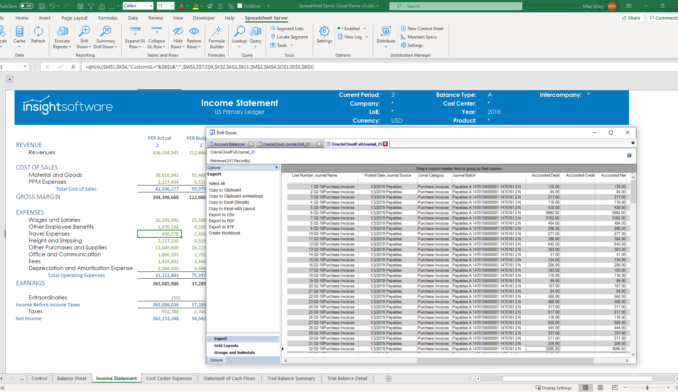From Marathon to Sprint: How to Speed Up Month-End Close with Real-Time Reporting

Speed has become a defining characteristic for competitive advantage during these uncertain times. The ability to assess the environment and act quickly has become a matter of life and death for many businesses. For the accounting department in particular, the ability to collect and collate information, analyze that data, and produce accurate financial and operational reports quickly has never been more important.
When the finance and accounting department can close the books faster, management can see problems earlier and address them sooner. It’s hard to imagine a football coach trying to adjust the team’s game strategy in the middle of the fourth quarter without knowing the score. C-level executives, likewise, need visibility to overall performance to make smart business decisions. That’s why a quick turnaround on month-end closing is critical.
All too often, speed comes at a cost. Conventional wisdom says that with fixed resources, faster execution will yield lower quality results. It isn’t necessarily true, though. With innovation and automation, finance and accounting leaders can increase both speed and accuracy in the month-end closing process.
Barriers to Getting the Job Done
The process begins with understanding some of the challenges that get in the way of an accurate and efficient month-end close:
Disparate systems: In today’s environment, most organizations are dealing with data stored in multiple systems. That may include enterprise resource planning (ERP) software, specialized billing or customer management applications, Excel spreadsheets, and external systems. Historically, one of the major challenges faced by accounting teams has been getting information from other departments, divisions, or external organizations.
Manual processes: With all those systems, most finance and accounting teams are faced with the tedious task of gathering reports, statements, and spreadsheets from multiple sources. In most cases, that information gets reentered into Excel by hand, or is copied and pasted in blocks of data or individual cells. That is a very tedious process that introduces the possibility of errors. A simple transposed number or misplaced decimal point can result in financial statements that do not accurately represent the state of the business.
Working from home: The coronavirus crisis has dramatically changed the way work gets done. Millions of employees around the world have shifted to a remote work model. That has presented new challenges, especially when collaboration and frequent communication across departmental boundaries are required.
Automation Is the Answer
The key to working smarter is found in automation. When an organization has clear, well-defined processes, and when it has automated as many components of that process as possible, this results in enhanced speed, accuracy, and efficiency.
A typical month-end close process involves creating or updating multiple worksheets. These may include things like a list of doubtful accounts, a calculation of goodwill to be amortized as part of an acquisition, or a schedule of fixed assets. Although some of these may involve one-off tasks or require very infrequent updates, many are routine and need to be done on a regular basis.
In many cases, worksheets must be validated against external sources. Often, that means reconciling the result to a general ledger account balance, but it may also include other kinds of validation. For example, inventory valuation from ERP should match physical inventory, which should match the general ledger, and so on.
Of course, Excel is the tool of choice for most accounting professionals for this type of work. After all, Excel is extraordinarily powerful and flexible. However, as a stand-alone tool, disconnected from the system of record, Excel lacks some important things. Even so, most people are still relying on tedious manual methods to populate data in Excel.
Automation changes that. With powerful, real-time reporting tools designed to work in conjunction with Excel, the process of retrieving information from multiple systems throughout your organization can be highly automated.
A manual process involves opening an Excel workbook, retrieving reports from various systems, copying or typing data in manually, and checking your work. Automation does all of that for you. Instead of spending time retrieving, copying, and rekeying data, accounting personnel can focus on what they do best.
Even journal entries can be automated. Imagine, for example, that you can automatically populate a list of overdue accounts receivable in Excel, then review that list to flag any questionable accounts. Now imagine that you can add a formula in the same Excel worksheet to retrieve the current GL balance for your “allowance for doubtful accounts.” From there, it’s a simple exercise to generate the required adjusting entry.
With the right technology, all of this can be driven by real-time data from your various information systems. If a customer pays off an old invoice, it will no longer show up in the list. If the GL account balance changes, the numbers are automatically updated in Excel. No copying, pasting, or rekeying of data is required.
Communication and Collaboration
With the shift to remote work, effective communication and collaboration are more important than ever. When steps in the closing process are automated and when data are populated based on real-time information from multiple systems, everyone is operating from a single source of truth.
To be effective, real-time reporting tools must provide the means to share data securely while preserving this unified view of the business. Real-time reporting tools from insightsoftware make it possible not only to automate many steps in the closing process, but also to share information with multiple stakeholders while ensuring that copies of important worksheets and reports are stored in a secure central location.
When multiple versions of a report are stored on the hard drives of individual laptops (or worse yet, on a non-secure personal computer), the situation can quickly become unmanageable. Hard-drive failures, lost or stolen laptops, or security breaches can result in the disclosure of confidential information and/or the loss of valuable data.
Roadmap to a Faster Month-End Close
Speeding up your month-end close process requires significant planning and effort, but it will undoubtedly yield positive results as your organization becomes better able to respond to a rapidly changing world.
So where do you start?
Begin by breaking down the closing process and documenting each step along the way. Many companies already have such a checklist of closing tasks. Who is responsible? Which information systems are involved? How is this step performed today?
Next, prioritize those activities based on materiality and risk. Accounts that don’t require frequent attention and are not material should be lower priority for the month-end close.
Finally, begin the process of assessing where automation could yield the biggest benefits. Which tasks consume the most staff time? Which ones lend themselves most easily to automation?
Shifting to an automation strategy doesn’t need to happen overnight. It is entirely reasonable to take a step-by-step approach to making it happen. It does require an intentional, strategic approach, however. Transformational improvement doesn’t happen by accident.
The month-end close process often evokes images of long hours and late nights at the office. That simply doesn’t need to be the case. With the right tools and a strategic approach to the problem, finance and accounting teams can meet high standards for delivering fast, accurate period-end reports.








